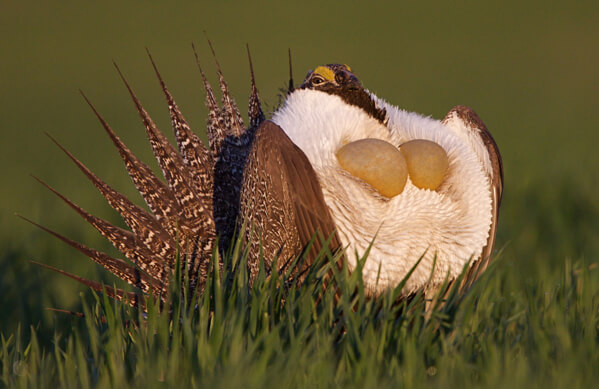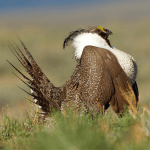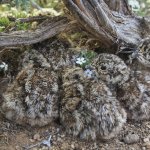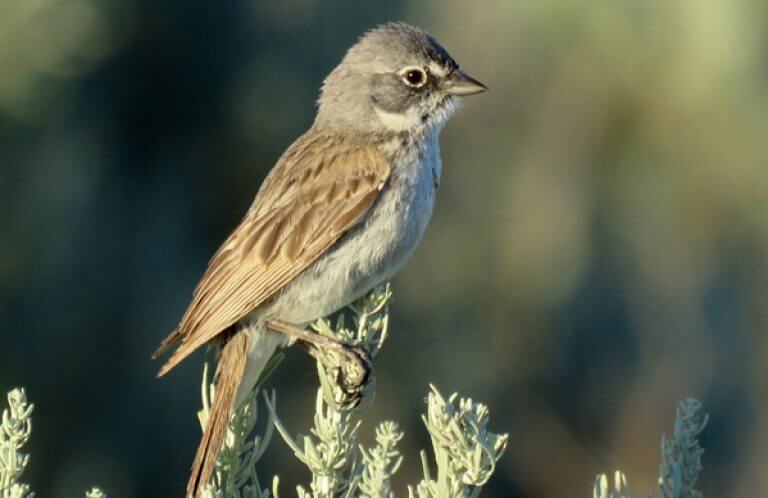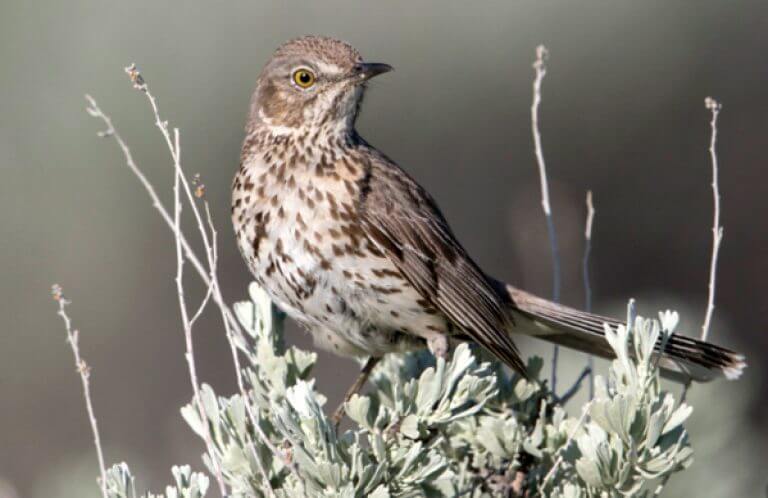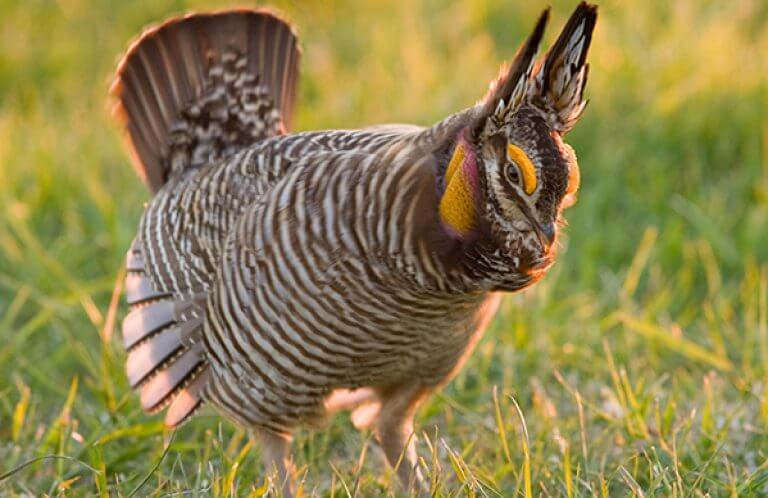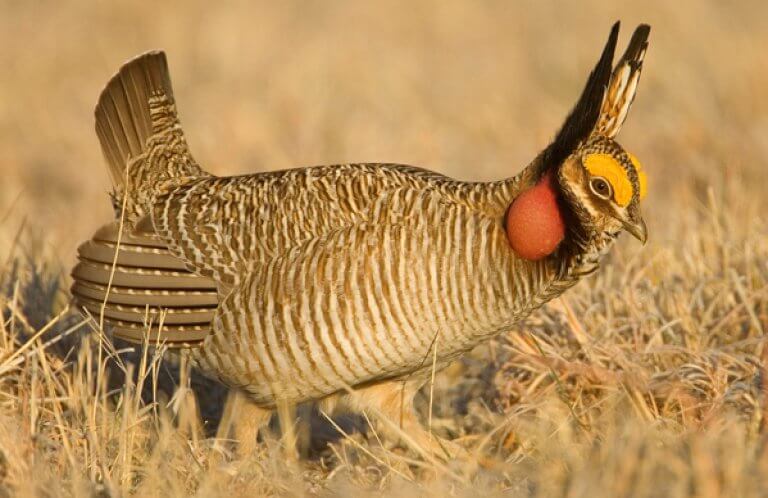About the Greater Sage-Grouse
Male Greater Sage-Grouse are well-known for their display "dances" on traditional gathering grounds known as leks. Traditional lekking grounds may be used for many years. Although many male sage-grouse gather to display at a lek, only a few are chosen by the majority of visiting females for mating. After mating, the females disperse to areas around the lek to nest.
Songs and Sounds
Greater Sage-Grouse utter a chicken-like cackling call when flushed from cover. Displaying males make a weird assortment of booming, swishing, and popping noises, produced by rattling their stiff tail and wing feathers and inflating and deflating their throat sacs.
(Audio: Sue Riffe, XC368674. Accessible at www.xeno-canto.org/368674 . Andrew Spencer, XC77183. Accessible at www.xeno-canto.org/77183 )
Breeding and Feeding
Life at the Lek, and Beyond
Each spring heralds a unique spectacle on brushy western plains of North America. Year after year, male Greater Sage-Grouse congregate on ancestral display grounds known as leks. There, the males strut about, fanning spiky tail feathers and raising feathered white collars while inflating bright yellow throat sacs — all the while making a weird assortment of booming, swishing, and popping noises. Female sage-grouse, the object of all this parading, look on with a critical eye.
Although male birds of other species, from the Greater Prairie-Chicken down to the Club-winged Manakin and Chilean Woodstar hummingbird, also display on leks, the Greater Sage-Grouse has come to represent a wider landscape.
Like other lekking species such as the Lesser Prairie-Chicken and Buff-breasted Sandpiper, the Greater Sage-Grouse male plays no role in raising the young. Hens nest under a sagebrush or other large shrub in a well-hidden, grass-lined depression on the ground. A hen lays and incubates a clutch of six to 10 eggs. The downy chicks hatch after two to three weeks and immediately walk out of the nest to follow their mother. In their first week of life, chicks eat many protein-rich insects, but switch to a plant-based diet as they mature.
Surviving on Sagebrush
Greater Sage-Grouse hens and their young sometimes gather with other females in food-rich areas. Post-breeding, other individual grouse may join these groups, sometimes forming winter flocks that number in the hundreds.
The quality of nesting habitat surrounding a lek is one of the most important factors for sage-grouse nesting success, with adequate cover being one of the most critical components.
The Greater Sage-Grouse needs large expanses of healthy sagebrush habitat to thrive. Since it lacks a muscular gizzard like other birds have, it cannot grind and digest hard seeds, and must feed on softer plant material. Sagebrush buds, leaves, and bunchgrasses constitute over 70 percent of its diet year-round, supplemented by insects, fruits, and small amounts of grit. The sage-grouse forages on the ground in open habitats, seeking sheltered feeding spots in harsh weather.
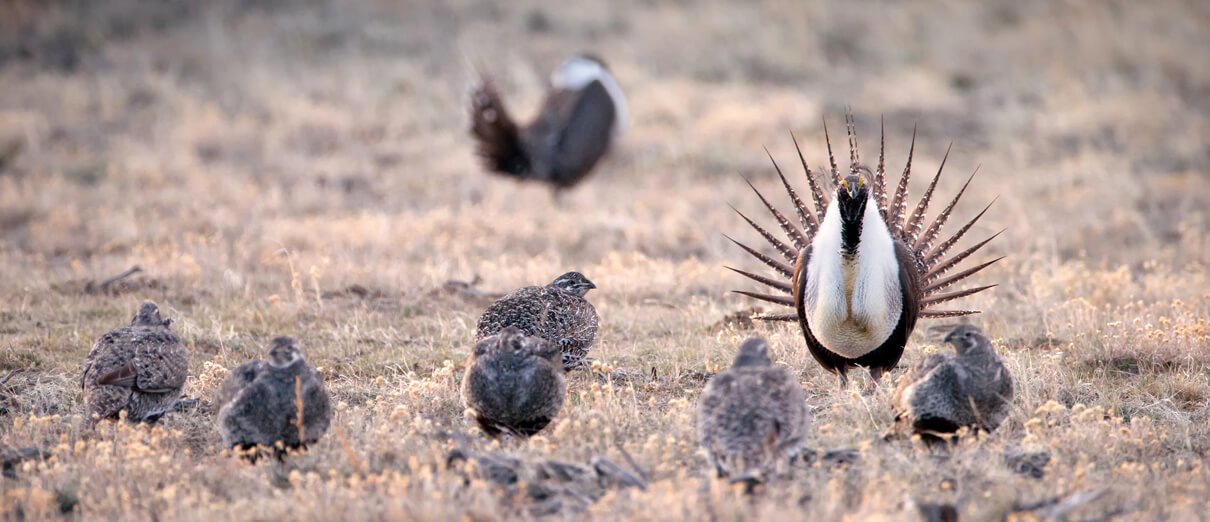
Region and Range
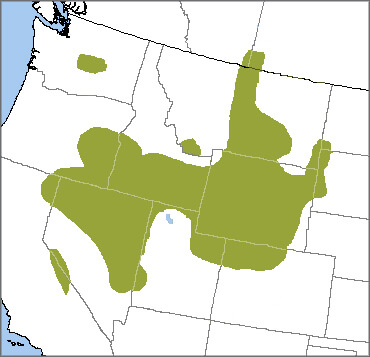
Although the Greater Sage-Grouse is a permanent resident throughout its range, it may make short seasonal movements sparked by food availability and weather. For example, some may move to lower elevations during the winter.
No subspecies of Greater Sage-Grouse are recognized, but there are distinct populations in Washington state and on the California/Nevada border. There is also the Gunnison Sage-Grouse, a closely related species, which occurs mostly in Colorado. Gunnison Sage-Grouse are significantly smaller in size and males have more noticeably barred tails.
Conservation
Symbol of the Sagebrush Sea
The charismatic Greater Sage-Grouse is an “umbrella” species, meaning that efforts to conserve it also benefit a wide variety of other wildlife. It is one of the most prominent inhabitants of the sagebrush "sea," which encompasses millions of acres of open lands across 13 U.S. states and small portions of a few Canadian provinces.
These plains are more complex than they first appear, with many varieties of native sagebrush, bunchgrasses, and wildflowers. The sagebrush sea is home to hundreds of bird species besides the grouse, including the Sagebrush Sparrow and Sage Thrasher, plus scores of other animals ranging from the unique Pronghorn antelope to the Great Basin Spadefoot toad. It is also an important migratory corridor for birds, and provides winter habitat for Mule Deer and Elk.
A Species and Ecosystem in Decline
Oil and gas development, overgrazing, sagebrush removal, invasive plants such as Cheatgrass, and wind energy facilities have significantly degraded Greater Sage-Grouse habitat. According to the Sage Grouse Initiative, only 56 percent of the sagebrush ecosystem remains, making it one of the country's most endangered habitats.
Greater Sage-Grouse sometimes collide with barbed wire fences and guy wires, and will avoid habitat near tall structures like wind turbines, communications towers, and powerlines.
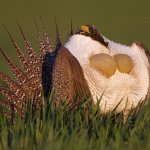
Help support ABC's conservation mission!
ABC's work to conserve the Greater Sage-Grouse — including advocating for effective management plans for the species on public lands — continues. Although its population is declining, this bird has yet to receive federal protection. In 2014, a rider was signed into law preventing its protection under the Endangered Species Act. The U.S. Senate recently dropped this rider from its Fiscal Year 2022 Interior Appropriations bill, a hopeful sign that additional conservation measures to stabilize declining Greater Sage-Grouse populations may soon become available.
Review of Management Plans: A Hopeful Sign?
On November 19, 2021, the Bureau of Land Management announced its intention to review current management plans for the Greater Sage-Grouse. ABC's Steve Holmer, Vice President of Policy, welcomed the news of possible conservation improvements and encouraged that additional steps be taken: “The grouse is on a trend line toward oblivion. It needs the backstop of the Endangered Species Act to ensure that any management changes are really going to stabilize and recover the species.
“The new plans need to address climate change and the significant role oil and gas development has played in grouse declines,” Holmer added.
Get Involved
Policies enacted by the U.S. Congress and federal agencies, such as the U.S. Fish and Wildlife Service, have a huge impact on America's birds. You can help shape these rules for the better by telling lawmakers to prioritize birds, bird habitat, and bird-friendly measures. To get started, visit ABC's Action Center.
Living a bird-friendly life can have an immediate impact on the birds around you. Doing so can be as easy as adding native plants to your garden, avoiding pesticides, and keeping cats indoors. To learn more, visit our Bird-Friendly Life page.
American Bird Conservancy and our Migratory Bird Joint Venture partners have improved conservation management on more than 6.4 million acres of U.S. bird habitat — an area larger than the state of Maryland — over the last ten years. This is a monumental undertaking, requiring the support of many, and you can help by making a gift today.





































